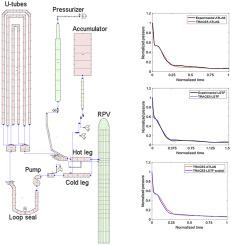当前位置:
X-MOL 学术
›
Prog. Nucl. Energy
›
论文详情
Our official English website, www.x-mol.net, welcomes your
feedback! (Note: you will need to create a separate account there.)
Scaling analysis of an IBLOCA counterpart test between the ATLAS and LSTF facilities
Progress in Nuclear Energy ( IF 3.3 ) Pub Date : 2020-09-01 , DOI: 10.1016/j.pnucene.2020.103460 M. Lorduy-Alós , S. Gallardo , G. Verdú
Progress in Nuclear Energy ( IF 3.3 ) Pub Date : 2020-09-01 , DOI: 10.1016/j.pnucene.2020.103460 M. Lorduy-Alós , S. Gallardo , G. Verdú

|
Abstract The experiments carried out in test facilities improve knowledge of the phenomena that would occur in a nuclear power plant during an accident, and support the validation of the thermal-hydraulic codes used in the nuclear safety analysis. Among them, counterpart tests between two facilities allow analyzing the different technology and scale effects, and the inherent distortion, in the evolution of a specific transient. Thus, counterparts contribute to address the scaling methodologies and enhance confidence in extrapolating results from the facilities to their reference power plants. The objective of this study is to analyze an Intermediate Break Loss-Of-Coolant Accident (IBLOCA) counterpart test at the ATLAS and LSTF facilities. The experiment is based on a 13% break in a cold leg, followed by the actuation of the High Pressure Injection (HPI), accumulators and Low Pressure Injection (LPI) systems. The study is supported by the simulation of the experiment with the TRACE5 thermal-hydraulic code. The results are compared with the available data of the A5.2 and IB-CL-05 tests, in the OECD-ATLAS and OECD/NEA ROSA-2 projects, respectively, in order to evaluate the prediction capabilities of TRACE5 and clarify the causes of the important differences between the transients. The analysis is completed by calculating the dimensionless groups derived from the first approach in the top-down scaling. The comparison of the groups determines, since an analytic point of view, the relevant phenomenology during the transient and the scaling distortion between both facilities. The system scaling analysis assesses a great similarity in the evolution of the main thermal-hydraulic parameters and in the operation of the safety systems throughout this transient.
中文翻译:

ATLAS 和 LSTF 设施之间的 IBLOCA 对应测试的扩展分析
摘要 在测试设施中进行的实验提高了对核电厂事故期间可能发生的现象的认识,并支持核安全分析中使用的热工水力规范的验证。其中,两个设施之间的对应测试允许分析特定瞬态演变过程中的不同技术和规模效应以及固有失真。因此,对应方致力于解决缩放方法并增强将结果从设施外推到其参考发电厂的信心。本研究的目的是分析在 ATLAS 和 LSTF 设施中进行的中间断路冷却剂损失事故 (IBLOCA) 对应测试。该实验基于冷腿休息 13%,随后是高压喷射 (HPI)、蓄能器和低压喷射 (LPI) 系统的启动。该研究得到了使用 TRACE5 热工水力代码的实验模拟的支持。将结果分别与 OECD-ATLAS 和 OECD/NEA ROSA-2 项目中 A5.2 和 IB-CL-05 测试的可用数据进行比较,以评估 TRACE5 的预测能力并阐明原因瞬态之间的重要差异。通过计算从自上而下缩放中的第一种方法导出的无量纲组来完成分析。从分析的角度来看,组的比较决定了瞬态期间的相关现象学和两个设施之间的缩放失真。
更新日期:2020-09-01
中文翻译:

ATLAS 和 LSTF 设施之间的 IBLOCA 对应测试的扩展分析
摘要 在测试设施中进行的实验提高了对核电厂事故期间可能发生的现象的认识,并支持核安全分析中使用的热工水力规范的验证。其中,两个设施之间的对应测试允许分析特定瞬态演变过程中的不同技术和规模效应以及固有失真。因此,对应方致力于解决缩放方法并增强将结果从设施外推到其参考发电厂的信心。本研究的目的是分析在 ATLAS 和 LSTF 设施中进行的中间断路冷却剂损失事故 (IBLOCA) 对应测试。该实验基于冷腿休息 13%,随后是高压喷射 (HPI)、蓄能器和低压喷射 (LPI) 系统的启动。该研究得到了使用 TRACE5 热工水力代码的实验模拟的支持。将结果分别与 OECD-ATLAS 和 OECD/NEA ROSA-2 项目中 A5.2 和 IB-CL-05 测试的可用数据进行比较,以评估 TRACE5 的预测能力并阐明原因瞬态之间的重要差异。通过计算从自上而下缩放中的第一种方法导出的无量纲组来完成分析。从分析的角度来看,组的比较决定了瞬态期间的相关现象学和两个设施之间的缩放失真。











































 京公网安备 11010802027423号
京公网安备 11010802027423号